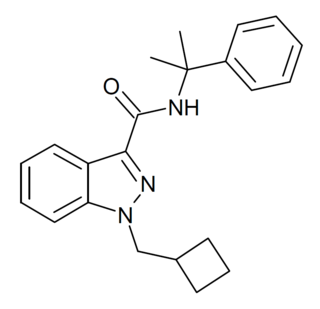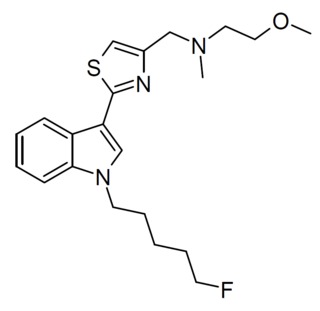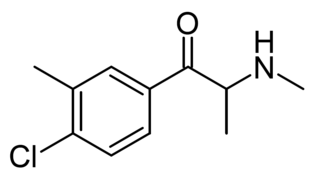
5-HO-DiPT (5-hydroxy-N,N-di-iso-propyltryptamine) is a tryptamine derivative which acts as a serotonin receptor agonist. It is primarily known as a metabolite of the better known psychoactive drug 5-MeO-DiPT, but 5-HO-DiPT has also rarely been encountered as a designer drug in its own right. Tests in vitro show 5-HO-DiPT to have high 5-HT2A affinity and good selectivity over 5-HT1A, while being more lipophilic than the related drug bufotenine (5-HO-DMT), which produces mainly peripheral effects.

5-MeO-DiBF is a psychedelic that has been sold online as a designer drug and was first definitively identified in December 2015 by a forensic laboratory in Slovenia. It is thought to act as an agonist for the 5-HT1A and 5-HT2 family of serotonin receptors. It is related in structure to the psychedelic tryptamine derivative 5-MeO-DiPT, but with the indole nitrogen replaced by oxygen, making 5-MeO-DiBF a benzofuran derivative. It is several times less potent as a serotonin agonist than 5-MeO-DiPT and with relatively more activity at 5-HT1A, but still shows strongest effects at the 5-HT2 family of receptors.

MDMB-CHMICA is an indole-based synthetic cannabinoid that is a potent agonist of the CB1 receptor and has been sold online as a designer drug. While MDMB-CHMICA was initially sold under the name "MMB-CHMINACA", the compound corresponding to this code name (i.e. the isopropyl instead of t-butyl analogue of MDMB-CHMINACA) has been identified on the designer drug market in 2015 as AMB-CHMINACA.

5-MeO-MALT (5-methoxy-N-methyl-N-allyltryptamine) is a lesser-known psychedelic drug that is closely related to 5-MeO-DALT and has been sold online as a designer drug.

4-HO-McPT (4-hydroxy-N-methyl-N-cyclopropyltryptamine) is a psychedelic tryptamine derivative. It has serotonergic effects, and has reportedly been sold as a designer drug since around 2016, but was not definitively identified by forensic laboratories until 2018. It is illegal in Finland.

CUMYL-CBMINACA (SGT-277) is an indazole-3-carboxamide based synthetic cannabinoid receptor agonist that has been sold as a designer drug, first being identified in Germany in February 2020. It is illegal in Finland.

PTI-3 is an indole-3-thiazole based synthetic cannabinoid which has been sold as a designer drug. It was first identified in Hungary in 2020, and was made illegal in Italy in June 2021.

Dipyanone is an opioid analgesic which has been sold as a designer drug, first identified in Germany in 2021. It is closely related to medically used drugs such as methadone, dipipanone and phenadoxone, but is slightly less potent.

4-Propionoxy-N,N-dimethyltryptamine is a synthetic psychedelic drug from the tryptamine family with psychedelic effects, and is believed to act as a prodrug for psilocin. It produces a head-twitch response in mice. It has been sold online as a designer drug since May 2019. It was first identified as a new psychoactive substance in Sweden, in July 2019.

Hydroxetamine is a recreational designer drug from the arylcyclohexylamine family, with dissociative effects. It is known as an active metabolite of the dissociative designer drug methoxetamine, but has also been sold in its own right since late 2019.

5-MeO-MET (5-Methoxy-N-methyl-N-ethyltryptamine) is a relatively rare designer drug from the substituted tryptamine family, related to compounds such as N-methyl-N-ethyltryptamine and 5-MeO-DMT. It was first synthesised in the 1960s and was studied to a limited extent, but was first identified on the illicit market in June 2012 in Sweden. It was made illegal in Norway in 2013, and is controlled under analogue provisions in numerous other jurisdictions.

Acetoxymethylketobemidone (O-AMKD), is an opioid designer drug related to ketobemidone, with around the same potency as morphine. It was first identified in Germany in October 2020.

4-Hydroxy-N-propyl-N-isopropyltryptamine (4-HO-PiPT, Piprocin) is a substituted tryptamine derivative which is claimed to have psychedelic effects. It acts as a 5-HT2A receptor agonist, with an EC50 of 13.8 nM and an efficacy of 104.8% (vs 5-HT), and has been sold as a designer drug, first being identified in 2021 in British Columbia, Canada.
The Trans-European Drug Information (TEDI) project is a European database compiling information from different drug checking services located on the European continent. The non-governmental organizations feeding into the database are referred to as the TEDI network.

4-Chloro-3-Methylmethcathinone (4-Cl-3-MMC) is a chemical compound from the substituted cathinone family. It has stimulant effects, and has been sold as a designer drug. It was first identified in Sweden in 2021. It is illegal in Italy and Finland, as well as under generic legislation in various other jurisdictions.

3-Fluoro-N-ethylbuphedrone (3F-NEB) is a substituted cathinone derivative with stimulant effects which has been sold as a designer drug. It was first identified in Sweden in 2021.

2-Methyl-alpha-PVP (2-Me-PVP) is a substituted cathinone derivative with stimulant effects which has been sold as a designer drug. It was first identified in Sweden in 2021.

3-Methylmethamphetamine (3-MMA) or Metaphedrine is an amphetamine derivative which has been sold as a designer drug, first being reported in Sweden in 2021.

Deschloroclotizolam is a thienotriazolodiazepine derivative which has been sold as a designer drug, first being identified in Sweden in 2021.

1cP-AL-LAD is an analog of lysergic acid diethylamide (LSD) which has psychedelic effects and is thought to act as a prodrug for AL-LAD. It has been sold as a designer drug, first identified in France in June 2021.



















